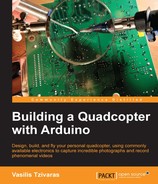Book Description
Design, build, and fly your personal quadcopter using market electronics to capture incredible photographs and record phenomenal videos
About This Book
- Grasp the knowledge required to assemble your drone with light and cost effective materials
- Enlighten your understanding about the flight by performing step-by-step pre-flight adjustments and acquiring the instructions for a safe flight
- Get the best tips to deal with performance issues related to your quadcopter
Who This Book Is For
This book is intended for hobbyists who are looking forward to fulfill their dream of flying a quadcopter clearly made by them. Some basic experience in electronic circuits and aerial vehicles will make it easier for you, however it isn't mandatory.
What You Will Learn
- Review and choose the most suitable material for the build
- Set up and calibrate all of your electronic parts
- Control and fly your quadcopter taking into account the weather conditions
- Maintain your vehicle as much as possible and repair it whenever required
- Engineer the structure of your vehicle
- Develop a flight controller with its basic principles
- Eliminate possible malfunctions in the future
- Repair your drone if it crashes or faces any damage
In Detail
Quadcopters, also known as quadrotors, are gaining more and more popularity in today's world. With the help of these devices, anyone can have an “eye in the sky” and can monitor any place at any time. You can capture photographs and once a while and perform automated tasks. In this book, you will be informed about all the basic modules and electronics needed to fly a simple quadcopter. You’ll delve deep to create a fully-functional quadcopter quickly with the help of Arduino boards. Through this book, you’ll develop the skills needed to build a DIY drone that can capture pictures and record videos.
Style and approach
This is an easy-to-follow guide with pictorial depictions and technical descriptions to assemble your vehicle.
Downloading the example code for this book. You can download the example code files for all Packt books you have purchased from your account at http://www.PacktPub.com. If you purchased this book elsewhere, you can visit http://www.PacktPub.com/support and register to have the code file.
Table of Contents
- Building a Quadcopter with Arduino
- Table of Contents
- Building a Quadcopter with Arduino
- Credits
- About the Author
- About the Reviewer
- www.PacktPub.com
- Preface
- 1. Introduction to Quadcopters
- 2. Hardware Overview
- 3. Creating a Frame
- 4. Soldering the Electronics
- 5. Electronics Installation
- 6. Flight Controller Setup
- 7. Flight Instructions
- 8. Cameras and Extra Functions
- 9. Repair and Maintenance
- Index
